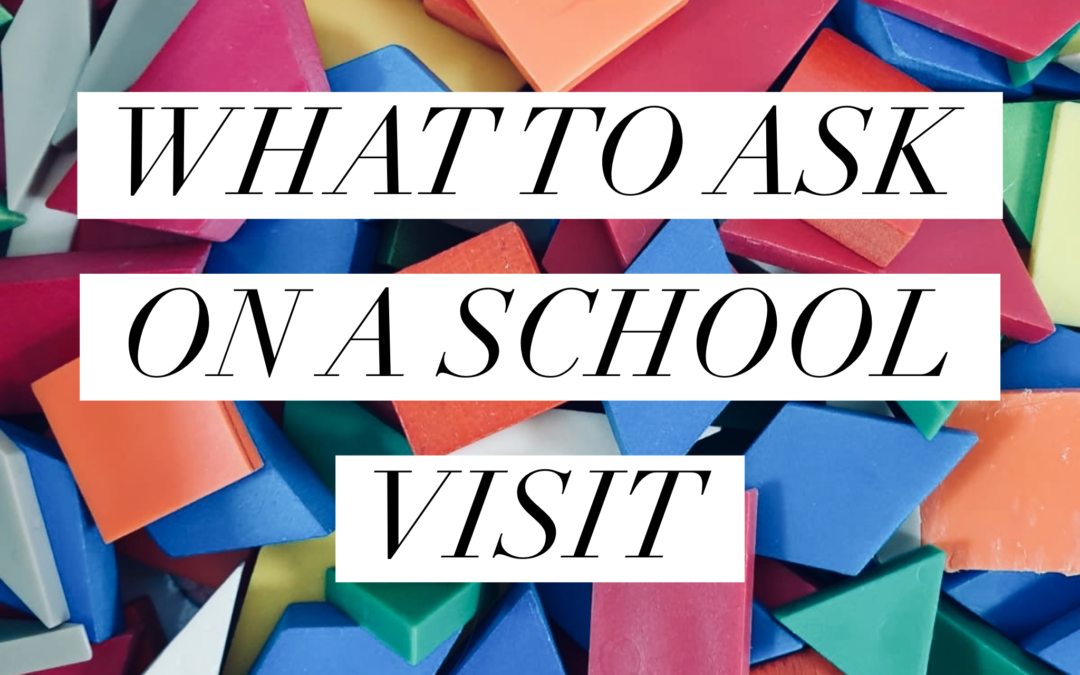So you’re getting organised and thinking about applying for your child’s Primary School place for September and you’re feeling smug about booking in some visits. Well done! But now what? If you’re worried about the impending ‘wander’ around a building full of small people with a professional teacher or Head teacher tour guide who is likely to say ‘have you got any questions?’ fear not, read on!
I’ve separated this post into two sections; Head and Heart. Actually ‘gut’ is probably more relevant than heart but it just doesn’t sound as friendly! This is because I feel that, as with lots of huge decisions we make in life when we’re pretending to be adults, there’s the practical aspects like ‘that’s not a sensible coat for the winter/ car with a baby in tow etc’ and then the deep seated feeling inside that tells you that somehow you must have it! So I’ve tried to sum up the key questions for both your head and heart which you might like to think about when visiting a school.

Let’s start with the ‘Head,’ the practical aspects that will affect your life for the next 7 years while your child attends Primary School.
Location – Do you want to be able to walk to the school? What is the journey like? If you are driving where can you park/ drop off? When you visit try the journey as you would do it in September. Lots of schools have limited parking options so if at all possible being able to walk or cycle will likely make your mornings much less stressful. You may want to consider schools which are near to family members or where you work. You will need to check if the school is likely to have space for children who live out of catchment area if you are considering one further away from your home.
Class organisation and sizes – On average how many children do you have in each year and class? Some schools will have a year group per class and others may have more than this. Larger schools may be 2 or 3 form entry. This means they take 2 or 3 classes each year. Legally class sizes for Reception, Year 1 and Year 2 should not be more than 30 children but in years 3-6 they can be larger. Some schools will also have mixed age classes. This is where children from two or more year groups are in the same class. This can work really well so don’t be put off by it. Do ask about how the lessons work though and whether children are separated into their year groups for certain subjects.
Timings – Do you need ‘wrap around care? This is childcare before or after school hours. Many Primaries offer breakfast and after school club options and if you work or have other commitments during your days, ask about this when you visit. Do children in Reception start full time or is there a staggered start? This is something you may need to consider if you work as you may need to book time off in September if the children do half days or similar for the first few weeks. If you have older or younger siblings think about where they will be going and what times you might need to drop them off and pick them up. If you are looking at Infant schools then there will be a time when they need collecting from different schools. Most Infant and Junior schools work together to plan slightly different times to each other so you don’t have to dash about.
Transition into school – If your child is in nursery or pre-school, ask which settings children come to the school from as it’s nice to know whether friends might be going to the same school. Does the school offer transition sessions before children start? Are there meetings for parents to attend and do teachers visit children in their nursery or at home before they start? If there is a pre-school on site you may want to think about your child spending some sessions there before September to build some friendships.
Food – What is on offer? Children in England can have free school lunches in Reception, Year 1 and Year 2 which is amazing for not needing to do packed lunches every day. Ask to see a menu if you are interested in the options.
Curriculum – This is a bit head and a bit heart actually as there may be parts of the curriculum that are really valuable to you as a family! Ask yourself, is there anything that for you is really key? If sport and being outdoors is important ask about how much time is spent doing sports and in which year groups. Ask about swimming, alternative sports, access to facilities, forest school and general use of outdoors for learning. If you are a techie family (or maybe you are really against too much tech time) then ask about how much time is dedicated to Computing, coding and ICT. Ask about the facilities and how much time children use technology for throughout the week. Schools are really focusing on their curriculum offers more than ever at the moment so it’s a good discussion to have if you can pinpoint subjects which you really want your child to love.
OFSTED – I’ve put this one last because these reports can be helpful or misleading depending on the date of review and any changes that have happened since. I’m not going to say too much about OFSTED reports other than; have a read if you are interested (you will find the latest one on the school’s website) but don’t let it rule your judgement. Go and see the school even if you are unsure about what the report says, you are likely to be pleasantly surprised.

The heart side of things is very much about how a setting feels. Here I’m going to ask lots of questions and really it’s about finding somewhere that you feel happy and comfortable sending your child. This will be so different for everyone. I know lots of Mums locally with children who are in nursery but only two of us use the same setting. It’s such a personal choice which will differ from person to person and child to child. Ultimately this is likely to be the part that makes up your mind and you may know instantly which school just feels ‘right’ for you and your child. It’s also the main reason we suggest you go and see at least 3 schools because you can only gauge so much from a website or OFSTED report!
Before you visited what was the communication like? Were the admin team happy and helpful? Did you get given all of the information you needed and did you feel welcome to come and see the school? Have a look at the website and see how much information you can find. School newsletters are interesting as they give you an insight into the weekly and monthly goings on and also the vibe!
When you arrive what is the welcome like? Many schools now have oppressive looking railings and fences around their grounds for safeguarding reasons but once inside is it clear how you get into the building and what are your first impressions? Is there someone in the office to help you? You will be asked to sign in and possibly read some safeguarding information which will be about who to report to if you are concerned about a child while you are visiting the school. Some schools also ask you to turn your phone off.
Who shows you around? This might be the Headteacher, another member of the Leadership team such as a Deputy or Assistant Head, a class teacher or sometimes children lead tours. Do the staff seem happy and friendly as you move around the school? Not all staff will be able to greet you as they may be busy supporting children but you will get feel for the atmosphere of the school. Ask those showing you around what the strengths of the school are and maybe what they are working on improving at the moment. Try asking ‘what do you like best about working here?
How are the children behaving when you walk around? And here I don’t just mean being polite. Are they busy, happy, focused, engaged? Can you imagine your child here? If it’s appropriate you could ask some children about the school. Try ‘What’s your favourite thing about school’ or ‘Can you tell me what you like best here?’
If you have your child with you on the tour looking at the way staff and children interact will be really useful. Do people talk to your child? Do they ask questions and are they friendly? After the visit what does your child say about it? Be careful about asking them too much, it’s possibly quite an overwhelming experience for them. Try telling them what you liked best or found interesting first and they are likely to respond with their own ideas.
This isn’t an exhaustive list of thinking points and I’m sure you will have other things which you question yourself. Hopefully you will enjoy visiting some local schools and will find making a decision relatively easy. Try not to get too stressed about the decision. While it feels like a huge deal and of course it is an important decision to think over and take seriously, ultimately there is time to make changes if you needed to. If for any reason it’s not working out once your child starts there is always the option to move. Remember that it’s best to put three choices down on your application. Good luck – I always believe you should trust your gut. If you get a good feeling about the school then lucky you, you may have found the place where the magic of learning is going to come alive for your child!
As always, any questions at all just contact us here or on our facebook or instagram pages.

